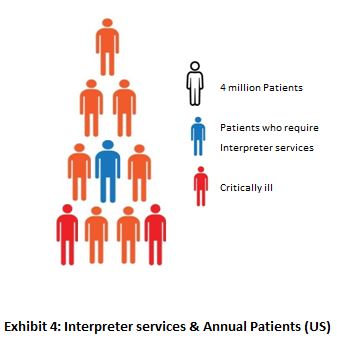Case Type: Growth Strategy
Case Style: Interviewer Led
Industry: Translation Services
Case Type: Growth Strategy
Industry:Translation Services
Case by Roland Berger Strategy Consulting
Our Client, Lingvist Solutions provides an online on-demand in-person language interpreter services; assisting clients in interpreting sign and foreign languages. They are based out of Dallas, Texas. Customers can avail their services anywhere round the world using simply their mobile phones or PCs and an internet connection. These services are provided using video or audio calls.

Lingvist Solutions started offering their services initially for all but soon focused its attention only on the airline industry due to high demand. They have seen great initial success in the airline industry and have tie ups with all major airline companies enjoying 60% of the market share. Over past few years, their sales have flattened and senior management is looking out for an appropriate growth strategy.
You have been hired for the job and is expected to provide an advice on developing a viable growth strategy plan for the client. What would you recommend ?
Interview Transcript Format
Candidate
So as I understood, our client Lingvist solutions, an online on-demand language interpreter service provider is looking forward to expand their business and have approached us for devising a viable growth strategy plan for them?
Interviewer
Thats Correct !!
Candidate
Do they have any specific growth targets/ returns in mind?
Interviewer
They are exploring possible avenues at this moment; Don’t have any particular targets.
I would like you to structure this problem first and tell me about the factors that you would consider & need for this analysis.
Candidate
Okay sure, a viable growth strategy for a service company like Lingvist Solutions, can be broadly discussed and devised under the following headings –
- INCREASE SERVICE CHANNELS
- Increase penetration in the current industry
This will include analysis of the current airline industry in context of services offered by our client. Whether or not client can adopt an aggressive penetration strategy will be a prime objective for this study. Different factors like market size, market growth, competition, pricing etc needs to be studied under this.
- Explore opportunities in other potential industries
Under this study, client can explore opportunities in the other potential industries, in case there isn’t enough demand to meet client’s expected growth in the current industry. The analysis will include studying potential industries for expansion on parameters like market size, growth, expected demand, competitors and barriers to entry. A few potential industries where such services maybe required are Hospitality & travel, Government & Pubic sector, Healthcare, Legal, Banking & finance etc
- INCREASE SERVICE LINES
An example of increasing service line could be expanding there current offerings to include support for additional languages. (Say if Lingvist currently support translations for English, Chinese & Spanish; they can expand there service offerings to additional languages like Arabic, Hindi, Portuguese & German etc)
- DIVERSIFY PRODUCT & OFFERINGS
- Invest in Technology
At present client offers in-person translation services over the internet. They can further invest in modern cutting edge technologies like AI (artificial intelligence) & Machine learning; thus developing products capable of providing on-demand machine based translation services. This will open an altogether new market of customers like tourists etc for whom accuracy of translation is not a big concern.
- Document translation services
They can also invest in creating softwares that can instantly convert documents from one language to the other. This can be used by students worldwide for understanding research papers written in other languages, help travelers understand their itinerary, business leaders in decoding international contracts, medical tourists in decoding their prescriptions etc
- INVEST IN MAJOR MARKETING CAMPAIGN
Client can also invest in major nationwide marketing campaigns to increase customer awareness and boost growth.
- ACQUIRE A COMPETITOR
For a rapid expansion, client can consider acquiring other small competitors in the same space, thus instantly getting access to their technology, platform & audience. This might be a good & effective strategy in case client is willing to expand to new geographies.
Interviewer
Great, that was quite a list.
To add to your knowledge, sales have been relatively flat over recent years for client. Thus they have limited access to funds at the moment. Therefore, acquisition of competition & investment in AI and Machine learning is a far fetched strategy for client.
Also, they are offering interpreter services in 10 different languages at present and feel that there is still enough scope to grow using the current offerings.
Candidate
Thanks for the information. With that in place, our analysis can be narrowed down to following possible strategies –
- Lingvist can either adopt an aggressive penetration strategy to increase market share in the current industry
- Or, they can explore other potential industries for expansion of their offerings
Interviewer
Good enough! Now have a look at the following exhibit and tell me what possible strategy can they adopt for the first point you just mentioned (i.e expansion into the current market) ?



Candidate
Insights from the exhibits can be summarized as below –
- Exhibit 1: Interpreter Services in the airline industry is provided either in-person via on-ground experts or via online channels like remote calls
- Remote calls channel caters to a majority of market needs (~75%)
- Lingvist caters to 70% demand (market share) originating from online channels
- Exhibit 2: For the last 3-4 years; the demand for interpreter services is witnessing a decline in the airline industry
- Exhibit 3: Lingvist is a premium service provider in the category ($20,000 as annual subscription charge with $6 per hour service availing charges over it)
Basis above insights it can be concluded that there is not much juice left for Lingvist in the airline industry; as the market itself is shrinking and Lingvist already enjoys a very high market share in it. Attempting to gain a higher market share under these conditions with premium pricing may eventually turn out to be a costly affair with non-sustainable returns.
Hence Lingvist must explore other industries as part of its future growth strategy plan.
Interviewer
Okay, makes sense. In that case, can you suggest a few other potential industries & business scenarios wherein Lingvist can fit in there offerings as it is?
Candidate
A few of the potential industries wherein Lingvist can expand as captured below –
- Hospitality & Travel
- Government & Public Sector
- Legal, Banking & Finance
- Healthcare etc
Interviewer
Lets talk about Healthcare industry in detail. Have a look at the following exhibits and tell me, does it look like a lucrative industry to expand for interpreter services as offered by Lingvist?


Following information is to be shared with the candidate only if requested –
- Interpreter services market in US is highly fragmented and dominated by Freelancers; providing in-person services on request
- A person would be categorized as Patient only if he gets admitted to the hospital
- Average time spent on interpreter services per year per patient = 120 mins
Candidate
These exhibits can be used to calculate market size and potential market share available for Lingvist in Healthcare industry.
But before that I would need to know more about other players and their market share, who are currently offering in the healthcare industry.
Interviewer
Interpreter services market in healthcare industry is highly fragmented and dominated by Freelancers; providing in-person services on request.
Candidate
Okay thanks, Insights from the above exhibits can be summarized as below –
- Exhibit 4: Annual Patients (people who get admitted to hospital) = 40 million
- Exhibit 4: Patients who require interpreter services = 4 million (~ 10%)
- Exhibit 4: Patients with critical illness = 8 million (~20%)
- Exhibit 5: Number of hospital in US ~ 5000
Since the interpreter services market in healthcare is dominated by Freelancers; we can use exhibit 3 (provided earlier) to figure out the Per hour service price as charged by them
- Exhibit 3: Per hour service price as charged by Freelancers = $60
Is there anything specific about critical patients? Any specific reason why they are highlighted? Do they need interpreter services or not?
Also, what is the average service time availed by the patients per year?
Interviewer
Ohh yes, I missed to mention: in-person interpreter services is a must for patients with critical illness and for ones suffering from psychological disorders (i.e. online interpreter services cannot be availed for critical patients)
And average service time needed per patient per year is 120 mins
Candidate
Okay, thanks. Basis the information captured so far, market size for interpreter services in healthcare industry can be calculated as below –

So, there is decent market to focus on in healthcare for online interpreter services. Also,
- Current interpreter services are dominated by Freelancers. There is no direct competition and the current market is highly fragmented & un-organized
- Moreover, service quality provided by Freelancers can at-times be unreliable and non-standard. Thus creating a market gap for Lingvist to pitch in and capitalize
Basis above analysis and insights, Lingvist is recommended to focus on Healthcare industry in its next growth strategy plan.
Interviewer
In that case what would be our client’s value proposition to the healthcare customers ? Why do you think hospitals would convert to their service?
Candidate
Certainly our standard & reliable on-demand 24 *7 online service will be a game changer for our healthcare customers.
On the cost front, an analysis is performed below to identify what hospitals are paying now vs what they would be paying if Lingvist gets on-boarded for availing interpreter services.
Current Scenario

Scenario with Lingvist
80% of the patients getting treated in hospitals can be switched to online interpreter services offered by Lingvist. (Other 20% patients with critical illness will still use in-person interpreter services from freelancers). Therefore,

Thus, hospitals are expected to save 51% in costs if they opt in for Lingvist as their major interpreter service provider.
Interviewer
That was a great discussion. Can you now quickly summarize your case findings and recommendation for CEO’s brief?
Final Recommendation
Lingvist solutions, an online on-demand service provider for language interpreter service is looking forward to identify focus points for its next growth strategy plan.
Lingvist is recommended to focus on expanding its services in the healthcare industry as –
- Demand for such services in the healthcare industry is decent enough and growing
- Current healthcare market lacks standardized & reliable interpreter service offerings. It is highly fragmented , unorganized and there exists no direct competition to Lingvist in the online space.
- Also, Hospitals (or, Customers) are expect to save 51% in costs if they opt in for Lingvist as their major interpreter service provider
Plan of Action (Next Steps)
- Devise an appropriate Go-To Market strategy
- Hiring & training of Sales executives to pitch in Lingvist’s services to potential clients
Risks involved
- Hospitals may resist switching to online services for psychological reasons
- Current Pricing plans may favor only the big customers (because of high subscription charges). On-boarding small hospitals would be a challenge with the current product pricing